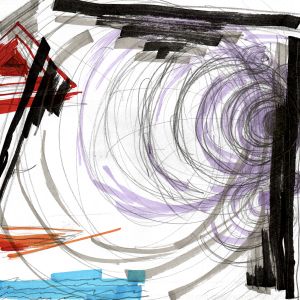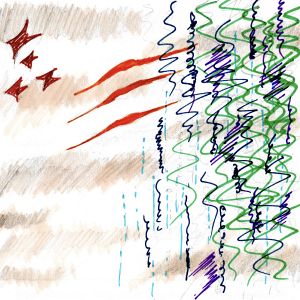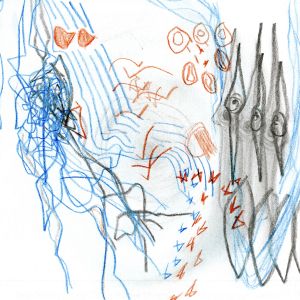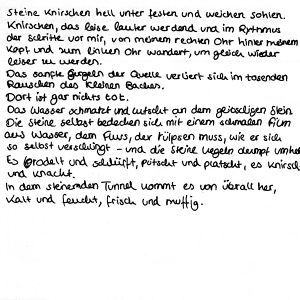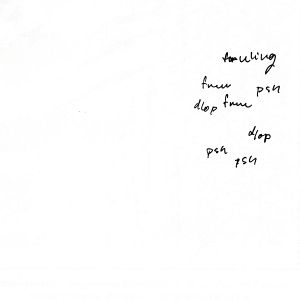m (Minor edit) |
|||
| Line 1: | Line 1: | ||
== | ==Learning the Grammar of Animacy (inspired by Kimmerer)<ref>Robin Wall Kimmerer, The Democracy of Species</ref>== | ||
''<nowiki>''</nowiki>I come here to listen, to nestle in the curve of the roots in a soft hollow of pine needles, to lean my bones against the column of white pine, to turn off the voice in my head until I can hear the voices outside it: the 'shhh' of wind in needles, water trickling over rock, nuthatch tapping, chipmunks digging, beechnut falling, mosquito in my ear, and something more - something that is not me, for which we have no language , the wordless being of others in which we have no language, the wordless being of others in which we are never alone.'' | |||
''[...]'' | |||
''Listening in wild places, we are audience to conversations in a language not our own.'' | |||
''[...]'' | |||
''To name and describe you must first see, and science polishes the gift of seeing. I honour the strength of the language that has become a second tongue to me. But beneath the richness of its vocabulary and its descriptive power, something is missing, the same something that swells around you and in you when you listen to the world. Science can be a language of distance which reduces a being to its working parts; its a language of objects.<nowiki>''</nowiki>'' | |||
== '''Internal imagery and exploratory sketches'''<ref>R. Murray Schafer, A Sound Education: 100 Exercises in Listening and Sound-making</ref> == | |||
'''The following worksheets, I have created to help explore the soundscapes of our immediate environment.''' | |||
'''Beginning with internal imagery and exploratory sketches, they aim to elevate listening to a new, visual dimension. Next, familiar language can be employed to reconnect with the soundscape in a customary way. Finally, we step beyond our comfort zone by inventing unique, personal words for the sounds we perceive, which can be freely arranged on the page.''' | |||
I was inspired by Schafer's "A Sound Education: 100 Exercises in Listening and Sound-Making." | |||
[[File:E1.1.jpg|left|frameless]] | |||
=== Exercise 1 === | |||
Find a place where you can fully engage your senses— step outside your room if you’d like. Spend some time listening closely to the movement of sounds in your environment. | |||
Create '''a visual representation of the soundscape''' around you. Use colors, shapes, and patterns to express the sounds—avoid using any words. | |||
[[File:Ex1.2.jpg|left|frameless]] | |||
[[File:Ex1.3.jpg|left|frameless]] | |||
[[File:Ex2.1.jpg|left|frameless|[[File:Ex2.2.jpg|left|thumb]]]] | |||
=== Exercise 2 === | |||
Language as a reflection of your soundscape: Use several words to describe a sound from your environment (e.g., gurgling, splashing, bubbling, ...). | |||
[[File:Ex3.2.jpg|left|frameless]] | |||
=== Exercise 3 === | |||
Find onomatopoeic words for sounds like raindrops, streams, waterfalls, rivers, or ocean waves, for example: ''clasticy-shash, geeshian, retzensplats, gurglewoo, plittertonk, blibliboop, hwoosh, piddlip, splish, spankle-spickle, pli-pli...'' | |||
Invent one unique onomatopoeic word for each sound you hear. | |||
=== Closing questions may include: === | |||
* ''What constitutes sound?'' | |||
* ''How do sound events emerge from elastic bodies?'' | |||
* ''How can sound be visualized?'' | |||
* ''What are the symbolic, aesthetic, and emotional depths of (in this case) flowing water?'' | |||
Revision as of 07:19, 4 January 2025
Learning the Grammar of Animacy (inspired by Kimmerer)[1]
''I come here to listen, to nestle in the curve of the roots in a soft hollow of pine needles, to lean my bones against the column of white pine, to turn off the voice in my head until I can hear the voices outside it: the 'shhh' of wind in needles, water trickling over rock, nuthatch tapping, chipmunks digging, beechnut falling, mosquito in my ear, and something more - something that is not me, for which we have no language , the wordless being of others in which we have no language, the wordless being of others in which we are never alone.
[...]
Listening in wild places, we are audience to conversations in a language not our own.
[...]
To name and describe you must first see, and science polishes the gift of seeing. I honour the strength of the language that has become a second tongue to me. But beneath the richness of its vocabulary and its descriptive power, something is missing, the same something that swells around you and in you when you listen to the world. Science can be a language of distance which reduces a being to its working parts; its a language of objects.''
Internal imagery and exploratory sketches[2]
The following worksheets, I have created to help explore the soundscapes of our immediate environment.
Beginning with internal imagery and exploratory sketches, they aim to elevate listening to a new, visual dimension. Next, familiar language can be employed to reconnect with the soundscape in a customary way. Finally, we step beyond our comfort zone by inventing unique, personal words for the sounds we perceive, which can be freely arranged on the page.
I was inspired by Schafer's "A Sound Education: 100 Exercises in Listening and Sound-Making."
Exercise 1
Find a place where you can fully engage your senses— step outside your room if you’d like. Spend some time listening closely to the movement of sounds in your environment.
Create a visual representation of the soundscape around you. Use colors, shapes, and patterns to express the sounds—avoid using any words.
Exercise 2
Language as a reflection of your soundscape: Use several words to describe a sound from your environment (e.g., gurgling, splashing, bubbling, ...).
Exercise 3
Find onomatopoeic words for sounds like raindrops, streams, waterfalls, rivers, or ocean waves, for example: clasticy-shash, geeshian, retzensplats, gurglewoo, plittertonk, blibliboop, hwoosh, piddlip, splish, spankle-spickle, pli-pli...
Invent one unique onomatopoeic word for each sound you hear.
Closing questions may include:
- What constitutes sound?
- How do sound events emerge from elastic bodies?
- How can sound be visualized?
- What are the symbolic, aesthetic, and emotional depths of (in this case) flowing water?
